Text

Cameo pendant. Gold. Made by Castellani. Circa 1860. The British Museum, 1978,1002.635.
"Gold pendant set with a sardonyx cameo of a female profile portrait bust and with a border of corded wirework in the 'archaeological style' with twisted wire circles on the pendant loop and open on the back with a monogram in gold wire."
#Victorian#Victorian fashion#19th century fashion#jewelry#jewellery#gold#sardonyx#Italy#Castellani#cameo#archaeological#filigree#engraving#twisted wire#granulation#albeit minimal#1860s
4 notes
·
View notes
Text
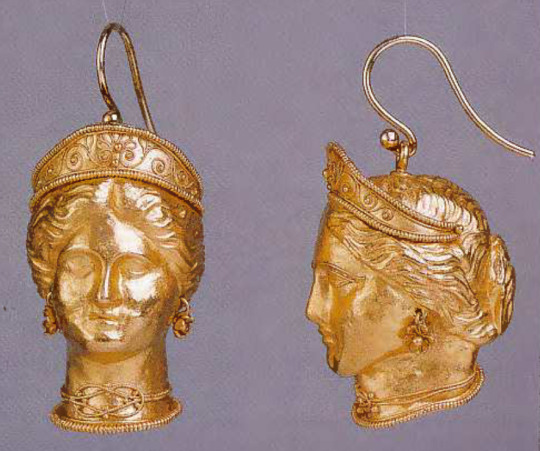
Pair of"Juno-head" earrings. Made by Castellani. Gold. French wires suspend the head and neck of a woman wearing a diadem, floral earrings, and a knotted necklace. The diadem and bottom of the neck are edged with beaded wire.
"It is [...] possible that one of the 'Juno-head' earrings is an ancient, but adapted object. This is suggested by various technical and stylistic variations, such as the treatment of the eyes and greater use of spiral beaded wire, and by a slight variation in gold composition, with the left one having gold of slightly lower purity. In addition, the other earring bears the Castellani double-C filigree monogram."
In Jack Ogden, "Revivers of the Lost Art: Alessandro Castellani and the Quest for Classical Precision." Castellani and Italian Archaeological Jewelry, p. 182.
12 notes
·
View notes
Text

The ROM's collection of mourning objects reveals the way in which women established a culturally determined code that incorporated many delicate, "feminine" motifs. Many of the most prevalent decorative designs were quite standardized and appeared on many different objects — for example, pearls represented teardrops. [...]
[This] brooch features a carved gold rim while its front is composed of gold as well as blue, black, and white enamel; its centre boasts the images of a lily and a forget-me-not, both of which were common symbols of death. This floral design is in turn surrounded by the motto, "Cut Down Like a Flower" and the brooch contains a plait of hair under glass on the opposite side (ace. no. 958.134.1) (Fig. 4).
Melissa Zielke, "Forget-Me-Nots: Victorian Women, Mourning, and the Construction of a Feminine Historical Memory." Material History Review 58 (Fall 2003), p. 57.
#brooch#mourning#gold#enamel#lily#forget me not#floral#hairwork#motto#glass#text#Melissa Zielke#1850s#1860s#1870s#1880s#1890s
2 notes
·
View notes
Text

Classical-style jewellery by the London firms of Robert Phillips, London & Ryder and Attenborough. Colour lithograph, J. B. Waring, Masterpieces of Industrial Arts & Sculpture at the International Exhibition of 1862 (London, 1863), vol. 2, plate 157.
#Victorian#jewellery#jewelry#Robert Phillips#Ryder and Attenborough#hair comb#necklace#earrings#neoclassical#1860s
1 note
·
View note
Text
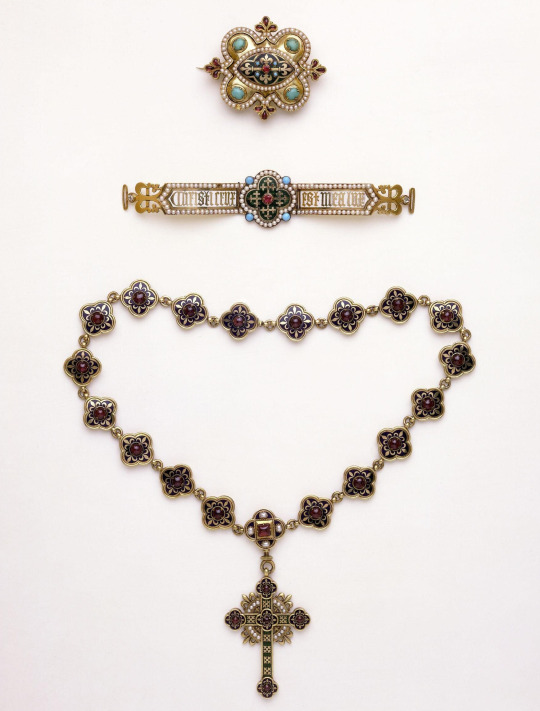
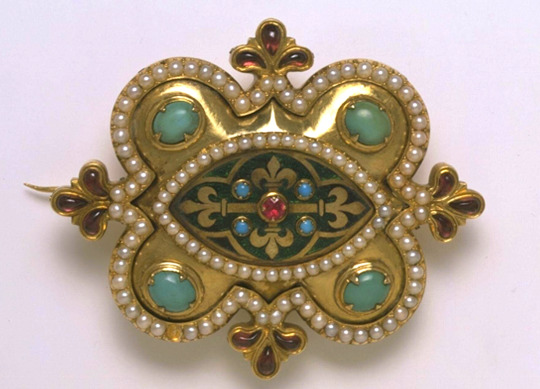

Parure of enamel and gem-set 'Mediaeval' jewellery, designed by A. W. N. Pugin for his wife Jane Knill in 1848 and displayed at the 1851 Great Exhibition in London. Victoria and Albert Museum, M.10-1962.
This Gothic revival set is "inspired by medieval ecclesiastical decoration"; the headband "bears the inscription 'CHRISTI CRUX EST MEA LUX' (Christ's cross is my [guiding] light)" (V&AM).
#Victorian#Victorian jewellery#A. W. N. Pugin#John Hardman & Co.#Medieval revival#revival#parure#headband#necklace#brooch#gold#enamel#ruby#diamonds#turquoise#pearls#quatrefoil#1840s#fleur de lis#Gothic revival#motto
16 notes
·
View notes
Text
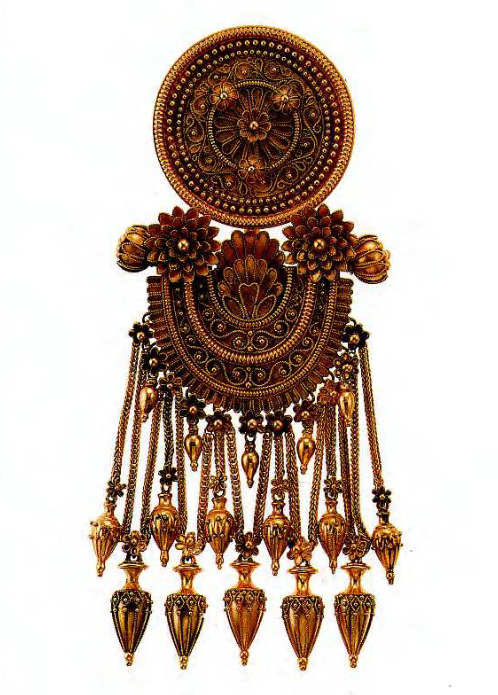

"Kul Oba" brooch. Design based on a Greek gold disk- and boat-shaped earring of ca. 350 B.C. Made by Castellani. Gold. Private collection.
"The precise use of thick beaded wires, wire ropes, and isolated grains can be seen, as well as the remarkably clean soldering and the even, matte gold surface color. The square-ended cuts, typical of the fine jeweler's saw used to cut round the petals (visible center), would never be seen on an Etruscan or Greek original."
--Jack Ogden, "Revivers of the Lost Art: Alessandro Castellani and the Quest for Classical Precision." Castellani and Italian Archaeological Jewelry, pp. 183, 187.
#19th century fashion#Victorian#victorian fashion#jewelry#brooch#gold#Castellani#Greek revival#neoclassical#archaeological
5 notes
·
View notes
Text

Parure of diamonds and pearls. Gift of the Prince of Wales to Princess Alexandra, 1863. Made by E. F. Dahl.
W. R. Russell, A memorial of the marriage of H.R.H. Albert Edward Prince ofWales and H.R.H. Alexandra Princess of Denmark, The Various Events and Bridal Gifts, illustrated by Robert Dudley (London, 1864), plate 28.
"In Denmark spectacular discoveries of ancient gold work from the Bronze Age, Iron Age and Viking periods came to light just as Denmark was struggling to protect its northern duchies of Schleswig-Holstein from the advance of Prussia. This was widely seen as a big country bullying a little one and there was huge political capital to be made out of it. Denmark's past became the means with which to promote a sense of nationalism. [...] By the time of the 1862 Exhibition in London, the Copenhagen jeweller E. F. Dahl had created an entire collection of ornaments 'adapted from the ancient Runic'. Some five different sets of jewellery in the new national style were chosen as wedding gifts for Princess Alexandra the following year. Her patronage of Danish retailers in London ensured the popularity of the Scandinavian style in jewellery well into the 1870s."
--Charlotte Gere and Judy Rudoe, "Jewellery at the 1862 Exhibition." The Journal of the Decorative Arts Society 1850 - the Present 38 (2014), pp. 82-105; pp. 91-3.
#Victorian jewellery#Denmark#Scandinavian#revival#diamonds#pearls#parure#tiara#earrings#necklace#brooch#1860s
1 note
·
View note
Text

A carved jet brooch (the most popular material with which to make mourning jewellery) showing two clasped hands above a floral swag (ace. no. 971.56) (Fig. 3).
"The symbol of two hands clasped above a floral swag was very popular in mourning jewellery of the period. The clasped hands indicate a ‘farewell’ or ‘last goodbye.’ The frilly cuff on the right hand side suggests that it is a woman's hand; her hand is being held by her departed husband, who will lead her into heaven."
--Melissa Zielke, "Forget-Me-Nots: Victorian Women, Mourning, and the Construction of a Feminine Historical Memory." Material History Review 58 (Fall 2003), pp. 59-60.
4 notes
·
View notes
Text

Gold and micromosaic brooch. Made by Castellani.
"Circular micromosaic depicting a dove brandishing a laurel branch, composed of tesserae in white, gray, turquoise, olive and gold hues, within a ropetwist frame accented by four finials, signed with interlocking Cs; circa 1865."
#Victorian#jewellery#fashion#jewelry#Victorian fashion#Castellani#micromosaic#gold#ropetwist#finials#laurel#dove#brooch#1860s
5 notes
·
View notes
Text
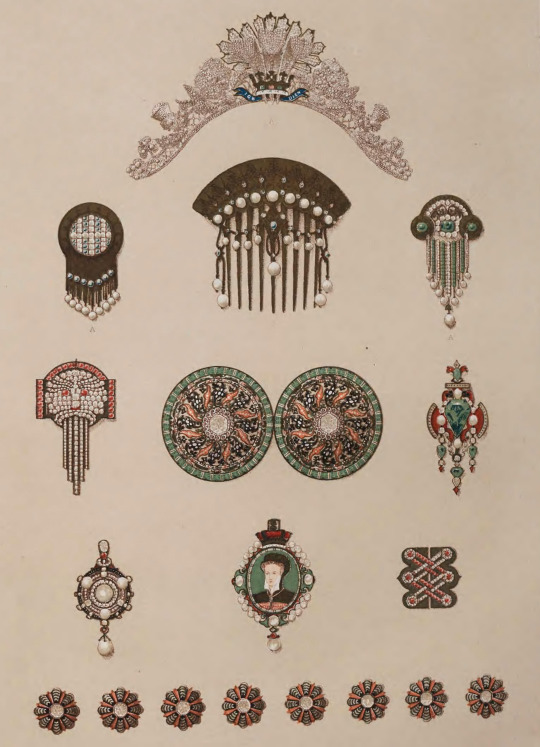
London. Chromolithographed and published by Day & Son Lithographers. A by Messrs Hunt & Roskell; the remainder by Messrs Garrard and Co. London.
In J. B. Waring, Masterpieces of industrial art & sculpture at the International exhibition, 1862 (1863), plate 129.
23 notes
·
View notes
Text


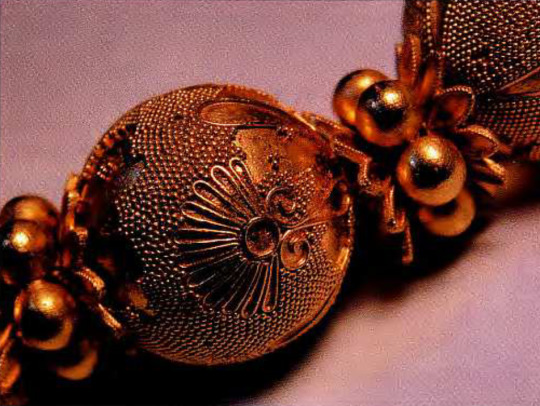
Necklace of granulated spheres. Made by Giacinto Melillo. Gold. Private collection.
"When Alessandro [Castellani] noted the hackly surface [on ancient Etruscan jewellery] where granulation was missing, it led him to investigate ways in which the solder filings might be introduced under rather than over the grains and filigree wires. On Castellani (and Melillo) jewelry with areas of powder granulation, the joints between the more substantial components of the jewelry reveal conventional solder seams, but the localized powder granulation shows evidence for soldering with very fine solder particles. These particles tend to be present among the granules and filigree, not on the neighboring components, and to be more in evidence under the grains than over them.
"Such an appearance would be all but impossible to produce with the traditional solder-sprinkling technique. One way it could be achieved was if the solder and flux particles were mixed with the gum or glue and painted onto the required area of the sheet gold and then the grains positioned on this. With the finest grain sizes it might even have been possible to mix grains, solder particles, ground flux, and glue together and "paint" all into position in one operation. An oil such as lavender oil, as used by painters in enamel, could have been substituted for the glue. If Alessarndro did use such a process to apply his solder it would have been a major change from the way in which filigree was traditionally soldered--and far more akin to contemporary enameling techniques with which he was also experimenting in the 1850s."
In Jack Ogden, "Revivers of the Lost Art: Alessandro Castellani and the Quest for Classical Precision." Castellani and Italian Archaelogical Jewelry, pp. 190.
#Victorian#jewelry#jewellery#Victorian jewelry#19th century#Castellani#necklace#granulation#powder granulation#gold#1850s#Giacinto Melillo
10 notes
·
View notes
Text

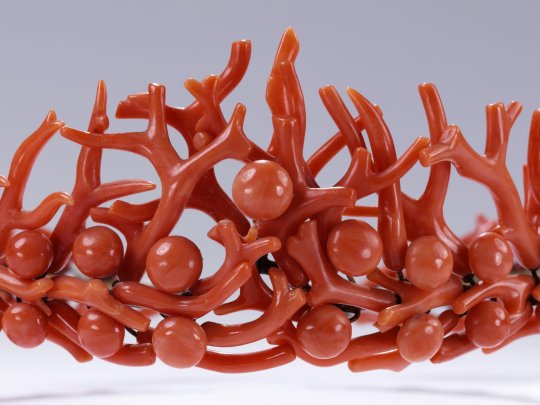
Tiara of coral branches and beads in the form of a wreath of sprays and berries. Made by Phillips Brothers. Circa 1860-70. Victoria and Albert Museum (M.10:1, 2-2003).
#Victorian#jewellery#jewelry#fashion history#Victorian fashion#1860s#coral#wreath#Phillips Brothers#tiara#berries#spray and berries
400 notes
·
View notes
Text
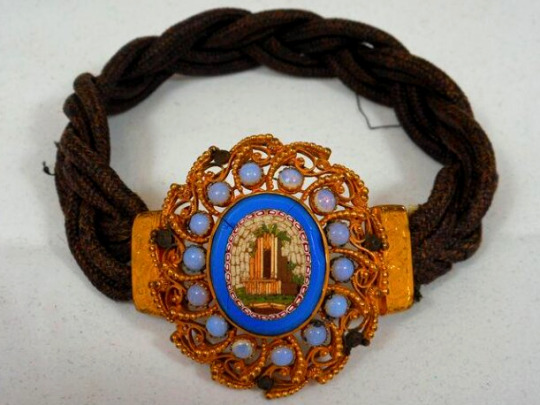
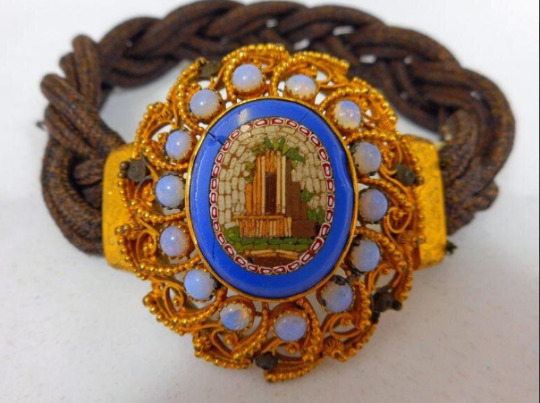
Micromosaic and hairwork bracelet, ca. 1855-1865
Dark brown human hair bracelet, twisted ropes of braided hair, with large yellow gold filigree clasp, set with small opals surrounding a central oval panel of pieta-dura mosaic work depicting an architectural fragment.
V & A Museum T.39-1918
#victorian#jewelry#jewellery#fashion#Italy#England#hairwork#micromosaic#gold#opals#pieta dura#1850s#1860s#filigree#architecture#ruins#granulation
5 notes
·
View notes